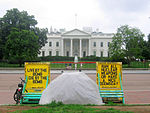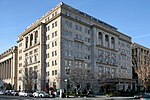Lafayette Square, Washington, D.C.

Lafayette Square is a seven-acre (30,000 m2) public park located within President's Park, Washington, D.C., United States, directly north of the White House on H Street, bounded by Jackson Place on the west, Madison Place on the east and Pennsylvania Avenue on the south. It is named for Gilbert du Motier, Marquis de Lafayette, a French aristocrat and hero of the American Revolutionary War (1775–1783) and includes several statues of revolutionary heroes from Europe, including Lafayette, and at its center a famous statue of early 19th century U.S. president and general Andrew Jackson on horseback with both of the horse's front hooves raised. The square and the surrounding structures were designated the Lafayette Square Historic District in 1970.
Excerpt from the Wikipedia article Lafayette Square, Washington, D.C. (License: CC BY-SA 3.0, Authors, Images).Lafayette Square, Washington, D.C.
Pennsylvania Avenue Northwest, Washington
Geographical coordinates (GPS) Address Nearby Places Show on map
Geographical coordinates (GPS)
| Latitude | Longitude |
|---|---|
| N 38.8995 ° | E -77.0366 ° |
Address
Andrew Jackson
Pennsylvania Avenue Northwest
20006 Washington
District of Columbia, United States
Open on Google Maps








